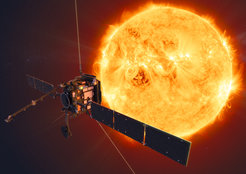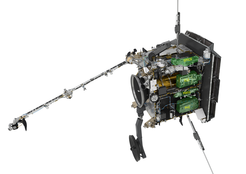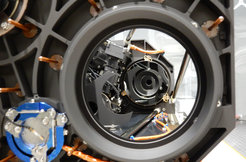Solar Orbiter passes endurance tests
European solar mission from Cape Canaveral into space scheduled to start in February 2020
A few months before its launch, the final preparatory phase for the ESA space probe Solar Orbiter has begun. In the past few months, in the IABG laboratories in Ottobrunn, it has been shown that the probe can withstand the rigours of a multi-year research expedition to the sun. Now that all test have been successfully completed, the relocation to the US is imminent. The National Aeronautics and Space Administration (NASA) is supporting the mainly European mission with rocket launches from Cape Canaveral in Florida, among other things. Over the next seven years, Solar Orbiter will investigate the solar wind – the constant particle flow from the sun – at its place of origin and fly closer to the sun than almost any other probe before it. The Max Planck Institute for Solar System Research (MPS) in Göttingen is decisively involved in four scientific instruments.

The influence of the sun extends more than 10 billion kilometres into space. Up to there, far beyond the orbit of Neptune, there is a flow of plasma of high-energy charged particles – which the Sun continuously ejects into space. The huge plasma bubble created in this way is referred to as the heliosphere. It shields our solar system from the interstellar medium – the thin plasma between the stars – and is our cosmic home.
Nevertheless, there are many unanswered questions about the properties of the heliosphere. While NASA’s Voyager probe, which was launched in 1977, seeks answers at the outermost edge of the solar system, the target of Solar Orbiter is in the opposite direction: as close to the Sun as possible to the origin of the solar wind. Only about 42 million kilometres – less than one third of the distance between the Earth and the sun – will temporarily separate the probe from our central star. Only NASA’s Parker Solar Probe has so far ventured closer to the solar fire.
“It is still unclear how the sun accelerates the solar wind into space and generates the heliosphere with it”, says Sami K. Solanki, Director at MPS and head of the team of scientists working with the solar orbiter telescope PHI (Polarimetric and Helioseismic Imager). Which processes in the outer layers and in the atmosphere of the sun enable it to catapult an average of one million tonnes of mass per second into space at speeds of more than three million kilometres per hour in some cases? And how does the changing nature of the sun affect the solar wind? Following a cycle of about 11 years, the sun sometimes appears as a calm ball of gas and sometimes as an unpredictable fireworks display of particle and radiation eruptions.
In order to answer these questions, one observation site is needed as close as possible to the sun and also two types of instruments. While four of the 10 Solar Orbiter instruments will directly study the solar wind that surrounds the spacecraft on site, the other six will look at its place of origin, the outer layers and the atmosphere of the sun. “This is the only way to relate the properties of the solar wind to the processes that create it”, says Udo Schühle of MPS, who coordinates the team working with the solar orbiter instrument EUI (Extreme Ultraviolet Imager).

One of the sun scouts among the instruments is the PHI double telescope, which was developed and built under the direction of the MPS. Among other things, the magnetic fields in the outer layers of the sun will be measured. While one partial telescope will keep an eye on the entire solar ball, the other will look at individual regions on the sun and can thus make magnetic structures with a size of only 200 km visible at the point closest to the sun. “The magnetic fields of the sun are the key to its changeable nature”, says Solanki. “Only with their help can we understand the processes that generate the solar wind and accelerate it into space”.
PHI will also be able to take a look inside – at least indirectly. The instrument will determine the speed at which the plasma on the surface of the sun moves towards or away from the observer. This will allow conclusions to be drawn about how the plasma propagates in the deeper layers of the sun – and thus provide access to the regions in which the alternating magnetic fields of the sun are generated.
The MPS is also contributing to three other solar orbiter instruments that will look at the sun. EUI will investigate the extremely short-wave ultraviolet radiation from the sun. This has its origin in the corona, the outer atmosphere of the sun, and makes it possible to study the fine structure of this gas envelope. The corona is also the focus of SPICE (Spectral Imaging of the Coronal Environment). The spectrograph will split the light from this region into its individual wavelengths and search for information about the regions of origin of the solar wind.
Metis will establish the connection between the solar atmosphere and the inner heliosphere. The coronagraph will make the area around the sun – which reaches up to two million kilometres into space – visible. In this way, researchers can observe how the solar wind particles behave at the onset of their long journey through the solar system.

Like all instruments on board Solar Orbiter that look to the sun, they are concealed behind a robust shield that will protect the inside of the probe from radiation and heat. The instruments can only look out through small “peep holes”, the doors of which are opened during the observation phases. The heat shield will reach temperatures of up to 500°C at the point of its orbit closest to the sun.
The flight towards the sun will only be possible through multiple passages by the Earth and Venus. The probe will thus gain momentum and be catapulted into a strongly elliptical orbit. The spaceship will also use the thrust from these encounters to gradually leave the plane in which the planets orbit the sun. Towards the end of the seven-year mission, the orbit of the Solar Orbiter will be at an angle of 24° to this plane. If the mission can be extended, an angle of 33° will be achieved.
“So far, all solar missions have observed their research object within the Earth’s orbital plane – and looked at the Sun’s belly, so to speak”, explains MPS scientist Hardi Peter, senior member of the SPICE team. In principle, this does not differ from the perspective offered by terrestrial solar telescopes. Only Solar Orbiter will be able to manage the change of perspective and thus a view of the higher latitudes of our star. There, in the polar regions, the solar wind constantly flows into space at particularly high speed. These areas are also regarded as the key to understanding the solar magnetic field.
BK














